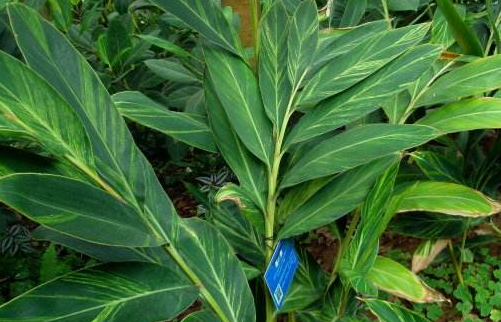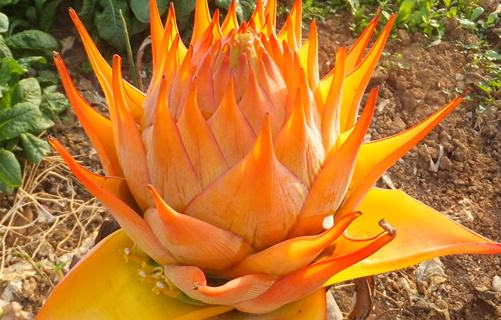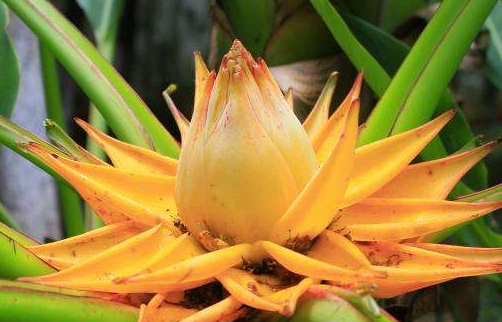Sowing of alpinia officinalis
Sowing time
Alpinia officinalis can be sown at any time except summer, but the best time is in autumn and winter, but the temperature is low in winter, so keep warm, for example, put alpinia officinalis in the greenhouse.

Sowing method
1. First of all, we should select a piece of fertile sandy land with good drainage, close to the water source and sunny. This kind of land had better be slightly acidic. Generally, we choose to sow and reproduce because we need a lot of seedlings and occupy a very wide area. The biggest advantage of sowing and reproduction is the emergence of a large area and a large number of seedlings, so we choose land with a large area.
2. After the land has been selected, it is necessary to make preparations. This preparation is usually carried out one month before sowing. First of all, we have to turn the soil. The thickness of the soil is about 25 centimeters. Secondly, after turning the soil, we should remove the weeds from the soil and flatten the land. In addition, we should fertilize the land so that they can absorb enough nutrients. Generally, fertilization can be carried out when turning the soil. Just mix the fertilizer directly into the soil.
3. Soak the seeds in warm water of about 50 degrees, then heat them after cooling, then heat them again, repeat them three times. Just pinch the seed and soften it.
4. When sowing seeds on a high bed, the distance between the seeds is 20 centimeters or more. A seeding pit can plant about 20 seeds and cover the soil two centimeters above. If there are conditions, you can use fire-soil gray hair as a surface cover.
What is the difference between alpinia officinalis and Amomum villosum? how to grow alpinia officinalis?
Upon hearing the name, Yanshan ginger thought it was ginger produced by Yanshan. In fact, it has nothing to do with ginger. Its inflorescence is paniculate, the sense of drooping is obvious, the flowers are white, and the top is pink. They look very beautiful and can be used for viewing. The following editor will introduce its planting method, and friends who like it can plant it themselves.
What is the difference between alpinia officinalis and Amomum villosum
1. Shape feature
Alpinia officinalis can be up to 3 m tall, leaf blade lanceolate, base attenuate, margin pubescent, both sides glabrous; panicle racemose, drooping, inflorescence axis purplish red, branches very short, bracteoles elliptic, white, apical pink, flowers wrapped in buds, lobes oblong, milky white, apical pink, labellum spatulate-broadly ovate, ovary covered with golden coarse hairs; seeds angular.
Amomum villosum its plant height 1.5-3 m, stem scattered; rhizome creeping ground, nodes covered with brown membranous scales. The rhizome is stout, brownish red. The seed group is divided into 3 petals, each petal has 5-9 seeds, the seed smell is fragrant and strong, used as spice, slightly spicy, its taste is like camphor.
2. Growth habits
Alpinia officinalis is not cold-resistant and can only withstand a temperature of about 8 ℃. When the temperature drops to about 10 ℃, wrap the plant with paper, put on a plastic bag and store it in the room to survive the winter. The ground must be planted in a shelter from the sun and can withstand slight frost. The Beginning of Winter can cut off the leaves and cover the roots with hay to avoid severe frost and damage to the roots. In this way, more new buds will sprout from the roots next spring, forming large clusters of plants. In the north, as long as you stay indoors, you can survive the winter safely.
Amomum villosum is cultivated or wild in the shady and humid places of the mountains, the shrinking sand is dense in the wet places under the forest, 600-800 meters above sea level; the dwarf Amomum villosum grows in the shady and humid places under the forest, 200 meters above sea level.
How to grow alpinia officinalis
1. Choose a piece of sandy land that drains smoothly, is close to the water source, and is sunny and fertile, preferably slightly acidic land. In general, the advantage of sowing seedlings is that they can emerge in a large area, so you can choose a large area of sand.
2. After selecting the land, prepare the land one month in advance, turn the soil at a depth of 25 centimeters, remove impurities and flatten it, and add appropriate amount of base fertilizer to replenish fertility. It can be directly mixed into the soil when turning deeply.
Build high-tech to raise seedlings. Trim a high bed with a width of 1 meter and a height of 25 centimeters, with an interval of 30 centimeters between each row, and smooth the bed surface.
3. Soak the seeds in warm water of about 50 degrees, then heat them after cooling, then heat them up after cooling, repeat three times. Just pinch the seed and soften it.
4. When sowing seeds on a high bed, the distance between the seeds is 20 centimeters or more. A seeding pit can plant about 20 seeds and cover the soil two centimeters above. If there are conditions, you can use fire-soil gray hair as a surface cover.
5. Cover the seeds with straw mats after planting. Soak the high bed with water until the soil is drenched. After that, the time of water supply will be determined according to the wetness of the soil. It can sprout in about twenty days to a month. After that, we can strengthen the management of water and fertility.
Can you eat alpinia officinalis?
Alpinia officinalis not only has good medicinal value, but also can be eaten by Siraya and Makadao people of the Pingpu ethnic group in early Taiwan, which are used to wrap zongzi. People in southern Taiwan also call alpinia ginger meat dumplings. At the same time, it is also used in pillow cushions, traditional cakes and Deep-Fried Glutinous Rice Cake Stuffed with Bean Paste, which taste different from bamboo leaves. The tender stem can be used as a substitute for ginger. In addition, in Luzhou, Sichuan, as well as parts of Chongqing and Guizhou, yellow rakes are wrapped with yangshan ginger leaves.
The efficacy of alpinia officinalis
1. Alpinia officinalis in the treatment of constipation
Alpinia officinalis is also divided into several kinds, of which the spring sand is the one with better quality. Alpinia officinalis can help digestion. Adding some alpinia officinalis to the dish can not only enhance the flavor and freshness, but also increase the appetite. Alpinia officinalis can treat constipation, people with constipation might as well eat more alpinia officinalis to recuperate the body, with high-fiber ingredients can increase the treatment of constipation problems. Alpinia officinalis can also be mixed with honey to drink, if the problem of constipation is very serious, you might as well try to use this method to recuperate.
2. Alpinia officinalis appetizer and invigorating spleen
Alpinia officinarum has been recorded in many medical books that alpinia officinalis is good for the stomach and kidney, helping to restore the breath of the stomach and kidney, improve flatulence, regulate stomach discomfort, and strengthen the spleen and stomach. Whenever there is abdominal distension in the stomach of the body, the problem that you don't want to eat can be recuperated by alpinia officinalis, which can help to improve your stomach discomfort and solve diseases such as lack of diet or vomiting. Friends who want to nourish qi and beauty might as well try Chunyan alpinia officinalis this ingredient, with ribs to cook soup, conditioning the body is the most desirable.
This kind of plant is not only beautiful, but also can be eaten, with more medicinal value, the whole body is really full of treasures, especially has the effect of appetizing and invigorating the spleen, when the appetite is bad, adding a little alpinia officinalis to the ingredients can instantly increase appetite, and when gastrointestinal discomfort is suitable, drinking some alpinia officinalis soaked in honey can play a very good conditioning effect.
Efficacy and function of alpinia officinalis and taboo on how to eat alpinia officinalis
Alpinia officinalis not only has beautiful appearance and high ornamental value, but also is a kind of traditional Chinese medicine. Its tuber can be used as medicine and has a good effect on the treatment of some diseases. But many people do not know what the effects of alpinia officinalis are, so let's introduce the medicinal value and edible method of alpinia officinalis to you in detail.
Efficacy, function and taboo of alpinia officinalis
1. The efficacy of alpinia officinalis in the treatment of constipation.
Alpinia officinalis is also divided into several kinds, of which the spring sand is the one with better quality. Alpinia officinalis can help digestion. Adding some alpinia officinalis to the dish can not only enhance the flavor and freshness, but also increase the appetite. Alpinia officinalis can treat constipation, people with constipation might as well eat more alpinia officinalis to recuperate the body, with high-fiber ingredients can increase the treatment of constipation problems. Alpinia officinalis can also be mixed with honey to drink, if the problem of constipation is very serious, you might as well try to use this method to recuperate.
2. The effect of alpinia officinalis on appetizer and spleen.
Alpinia officinarum has been recorded in many medical books that alpinia officinalis is good for the stomach and kidney, helping to restore the breath of the stomach and kidney, improve flatulence, regulate stomach discomfort, and strengthen the spleen and stomach. Whenever there is abdominal distension in the stomach of the body, the problem that you don't want to eat can be recuperated by alpinia officinalis, which can help to improve your stomach discomfort and solve diseases such as lack of diet or vomiting. Friends who want to nourish qi and beauty might as well try Chunyan alpinia officinalis this ingredient, with ribs to cook soup, conditioning the body is the most desirable.
Taboo: there are no taboos for eating.
How to eat alpinia officinalis
Alpinia officinalis not only has good medicinal value, but also can be eaten by Siraya and Makadao people of the Pingpu ethnic group in early Taiwan, which are used to wrap zongzi. People in southern Taiwan also call alpinia ginger meat dumplings. At the same time, it is also used in pillow cushions, traditional cakes and Deep-Fried Glutinous Rice Cake Stuffed with Bean Paste, which taste different from bamboo leaves. The tender stem can be used as a substitute for ginger. In addition, in Luzhou, Sichuan, as well as parts of Chongqing and Guizhou, yellow rakes are wrapped with yangshan ginger leaves.
Main value
1. Afforestation value
Alpinia officinalis has broad leaves and gorgeous colors, so it is an excellent foliage plant. Set off under the wax stone, it gives people a sense of vitality. Planting next to a stream or in the shade of a tree can give people the pleasure of returning to nature and enjoying wild fun.
2. Edible value
The Siraya and Makadao people of the Pingpu people in early Taiwan were used to wrap zongzi. Southern Taiwan residents also called Yanshan ginger meat dumplings, as well as pillow cushions, traditional cakes and Deep-Fried Glutinous Rice Cake Stuffed with Bean Paste, which tasted different from bamboo leaves. The tender stem can be used as a substitute for ginger. In addition, in Luzhou, Sichuan, as well as parts of Chongqing and Guizhou, yellow rakes are wrapped with yangshan ginger leaves.
3. Manufacturing woven goods
The Paiwan and Rukai aborigines in Taiwan use the stem-shaped leaf sheaths of alpinia officinarum. After harvesting and drying before flowering, the fibers are extracted to weave into ropes, blue, plates, baskets, mats or straw mats, while fishermen in northern Australia weave large ropes to tie anchors.
How to grow alpinia officinalis
1. Choose a piece of sandy land that drains smoothly, is close to the water source, and is sunny and fertile, preferably slightly acidic land. In general, the advantage of sowing seedlings is that they can emerge in a large area, so you can choose a large area of sand.
2. After selecting the land, prepare the land one month in advance, turn the soil at a depth of 25 centimeters, remove impurities and flatten it, and add appropriate amount of base fertilizer to replenish fertility. It can be directly mixed into the soil when turning deeply.
Build high-tech to raise seedlings. Trim a high bed with a width of 1 meter and a height of 25 centimeters, with an interval of 30 centimeters between each row, and smooth the bed surface.
3. Soak the seeds in warm water of about 50 degrees, then heat them after cooling, then heat them up after cooling, repeat three times. Just pinch the seed and soften it.
The above is the efficacy and eating method of alpinia officinarum summarized by the editor. I hope it can be helpful to everyone! Alpinia officinalis is a treasure, a kind of green plant with high ornamental value, at the same time, it has certain medicinal value to treat some diseases, and even has the habit of using alpinia officinalis as spice in some places, which is always assisted by it in cooking delicacies.
- Prev

How to raise Jinlian in Diyong
Temperature Yong Jinlian likes to grow in a warm environment, so pay attention to keep the plant warm in winter to avoid frostbite, its cold tolerance is relatively poor. Jinlian likes sunshine very much. Only by receiving enough light during the growing period can it grow healthily. Pay attention to it in summer.
- Next

Matters needing attention in the cultivation of Golden Lotus in Diyong
There are strict requirements when watering Jinlian in Diyong. Watering should be appropriate, not too much, so that there is stagnant water in the basin, and do not put the plant outside in rainy weather, so as to avoid stagnant water in the basin. If there is stagnant water in the basin, it is easy to cause the root system of the plant to rot. The cold resistance of Di Yong Jinlian is very poor.
Related
- Fuxing push coffee new agricultural production and marketing class: lack of small-scale processing plants
- Jujube rice field leisure farm deep ploughing Yilan for five years to create a space for organic food and play
- Nongyu Farm-A trial of organic papaya for brave women with advanced technology
- Four points for attention in the prevention and control of diseases and insect pests of edible fungi
- How to add nutrient solution to Edible Fungi
- Is there any good way to control edible fungus mites?
- Open Inoculation Technology of Edible Fungi
- Is there any clever way to use fertilizer for edible fungus in winter?
- What agents are used to kill the pathogens of edible fungi in the mushroom shed?
- Rapid drying of Edible Fungi

